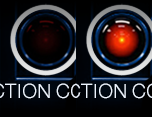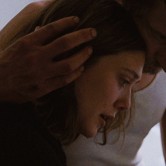Movie Review: LET THE RIGHT ONE IN (2008)
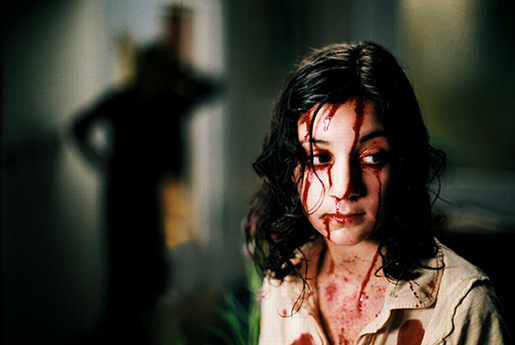
Rare, Bloody and Tender
First, I would like to single out a scene that is pivotal to the overall success of Let the Right One In. Oskar, a twelve-year-old Swedish boy (Kåre Hedebrant), whose parents are separated, is visiting his father (Henrik Dahl) over the weekend. Late in the night, the two are having a blast playing tic-tac-toe. They are interrupted by a visitor whose presence subtly changes the course for the rest of the evening. The last grim exchange between the father and son expresses so much hurt and understanding about the how and why. It doesn’t need to be explained. It is simply felt. This scene sounds like it belongs in a serious drama. It is, but Let the Right One In is also a vampire movie – as sophisticated and thoughtful a horror film as you are likely to find.
This film, like so few can, redeems the horror genre. So many cynical filmmakers belittle their horror films because they don’t believe the genre is worthy. You can browse shelves of horror titles and find only one success out of thirty failures. Thankfully, Let the Right One In joins the ranks of great vampire films like Kathryn Bigelow’s Near Dark (1987), both of the 1922 (dir. F.W. Murnau) and 1979 (dir. Werner Herzog) versions of Nosferatu, and its cunning companion Shadow of the Vampire (2000) by E. Elias Merhige. Let the Right One In is the real thing. Set in Sweden – 1982, it uses vampire logic in an environment as cold, cruel and recognizable to our own. There are moments of invention such as what happens when a vampire trespasses property where an invitation has not been given. Here, vampires get burned when touched by sunlight – they don’t (*shudder*) sparkle.
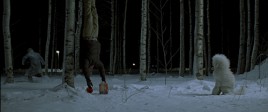 Living next door to Oskar is Eli (Lina Leandersson), a young vampire who looks like a twelve-year-old girl, but it is more complicated than that. There is an alarming shot of her behind a door that’s ajar — you know the one. She is sheltered by an older deviant (Per Ragner) who appears to be under a spell as he fetches her blood from victims he kills and drains. She would have been better off sending the Ice Truck Killer to perform this task. Upon further reflection, this character may be a possible outlook into the future of what Oskar will become when he reaches adulthood.
Living next door to Oskar is Eli (Lina Leandersson), a young vampire who looks like a twelve-year-old girl, but it is more complicated than that. There is an alarming shot of her behind a door that’s ajar — you know the one. She is sheltered by an older deviant (Per Ragner) who appears to be under a spell as he fetches her blood from victims he kills and drains. She would have been better off sending the Ice Truck Killer to perform this task. Upon further reflection, this character may be a possible outlook into the future of what Oskar will become when he reaches adulthood.
Eli encounters Oskar one night and she grows protective of him. They form a fragile friendship that could also be described as eternal. No matter how high the body count mounts, Eli remains sympathetic because she cares for Oskar and her cursed hunger is blameless. They are both tortured souls.
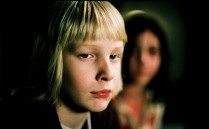 Poor Oskar is quiet and misunderstood. In class, a policeman asks the kids why a killer would use a peculiar method in a murder case. Oskar volunteers a clever, albeit logical answer that would have invited the policeman to propose that Oskar study to become a sleuth because there is a desk waiting at Homicide with his name on it. Instead, the policeman humiliates Oskar by insinuating that a brainy kid not intimidated by dark subject matter is a would-be felon who should be monitored carefully. Oskar sheepishly explains that he reads a lot. The policeman grills him, demanding, “What kinds of books?” Oskar repeats himself, “I read a lot.” No wonder smart kids keep quiet.
Poor Oskar is quiet and misunderstood. In class, a policeman asks the kids why a killer would use a peculiar method in a murder case. Oskar volunteers a clever, albeit logical answer that would have invited the policeman to propose that Oskar study to become a sleuth because there is a desk waiting at Homicide with his name on it. Instead, the policeman humiliates Oskar by insinuating that a brainy kid not intimidated by dark subject matter is a would-be felon who should be monitored carefully. Oskar sheepishly explains that he reads a lot. The policeman grills him, demanding, “What kinds of books?” Oskar repeats himself, “I read a lot.” No wonder smart kids keep quiet.
It is no surprise that Oskar is targeted by bullies at school who know what little they do can scar. What they do later is much worse. Feeling alienated, Oskar is compelled to stab a tree with his knife (“Squeal!”) because he can’t punish his tormentors. Eli encourages him to fight back. What is most refreshing is how revenge is handled here and where it goes. Shades of gray, mostly dark, dominates the film’s moralistic point-of-view. One day, when Oskar is threatened of being pushed into a frozen lake, he does fight back. The way this scene is handled acknowledged how horrible violence can be, but knows in its heart how liberating it can be to inflict violence on a figure of hatred.
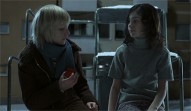 Director Tomas Alfredson takes this material seriously. The characters are fleshed out and they respond to a variety of supernatural events as real people would. The richly adapted screenplay by John Ajvide Lindquist was based on his book. This successful case is as familiar as Sam Raimi’s best feature A Simple Plan (1998), which was scripted by its author Scott B. Smith. Great care is taken to tell this story precisely while treasuring its foreboding atmosphere. There are occasional moments of levity to relieve the heavy grimness by relying on quirks and an appreciation for human nature. Some tense scenes become morbidly funny with the inclusion of a dog in one scene and many cats in another.
Director Tomas Alfredson takes this material seriously. The characters are fleshed out and they respond to a variety of supernatural events as real people would. The richly adapted screenplay by John Ajvide Lindquist was based on his book. This successful case is as familiar as Sam Raimi’s best feature A Simple Plan (1998), which was scripted by its author Scott B. Smith. Great care is taken to tell this story precisely while treasuring its foreboding atmosphere. There are occasional moments of levity to relieve the heavy grimness by relying on quirks and an appreciation for human nature. Some tense scenes become morbidly funny with the inclusion of a dog in one scene and many cats in another.
Cinematographer Hoyte Van Hoytema has fashioned a number of well-composed shots that are bleak, accomplished and essential. Some night scenes taken during snowfall have the purity of black-and-white films. The pictures manage to be vibrant as well as desaturated of obtrusive colours found in warm flesh tones. Here the heavy strings of blood look as black as oil. There is one particular establishing shot of gray, distant buildings layering over one another like a collage. There are so many windows that it is a joy to see one opened by Oskar, distorting the vocal point. Many other compositions are so symmetrical that they convey a scary power.
Tomas Alfredson is a superb and assured filmmaker because he takes the time to choose one great shot and keep it at length. Films with long shots have the ability to endure as the viewer explores the spaces and makes discoveries. The shot of Eli climbing a fourteen-foot tree is particularly ingenious because it gives us an impression – an idea – instead of weakening the act with unnecessary special effects that merely show us. Graphic violence is rarely used, but it makes an impression when it is shown. For example, there is a disfigurement that would make Two-Face blush. Alfredson exercises commendable restraint like with one long shot that shows the luring of a man and his murder from a distance. Instead of scaring the audience with loud music after a moment of silence, the film frightens on a deeper level. I can’t imagine another filmmaker doing a better job here.
Let the Right One In is so impeccably made that any attempt at a remake would be criminal. There is talk of Matt Reeves Americanizing Alfredson’s masterpiece for a 2010 release. What’s the point? Making these characters speak in English would only diminish the strange effect of listening to the Swedish language. Hearing “Are you a vampire?” in English sounds kind of funny. A foreign track is more surreal and reverent for this material. Reeves was the director of the overrated Cloverfield (2008) where the end credits sequence scored by Michael Giacchino was the only enjoyable part, but that was me. The chances are slim that this will reflect the case of Insomnia where Christopher Nolan made a stronger remake in 2002 from the 1997 Swedish film by Erik Skjoldbjærg. We’ll see.
Let the Right One In is a terrific vampire film and it’s waiting just outside.
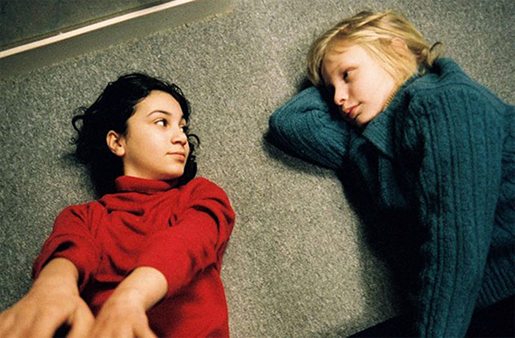
“Let The Right One In” Trailer
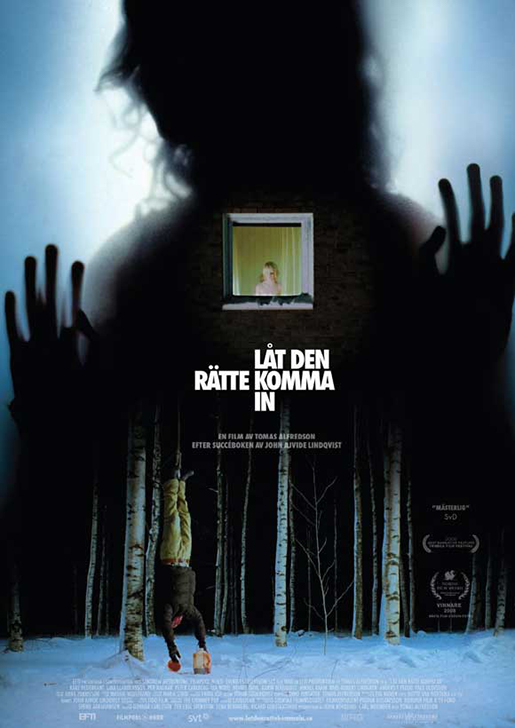
© 2008 – 2024, CINELATION | Movie Reviews by Chris Beaubien. All rights reserved.


